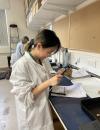Wenxin Zhang
Thesis title: Trauma and interpersonal violence in Early Iron Age Turpan, northwestern China

PhD Archaeology
Year of study: 5
- School of History, Classics and Archaeology
Contact details
- Email: wenxin.zhang@ed.ac.uk
PhD supervisors:
Address
- Street
-
William Robertson Wing, Teviot Place
- City
- Edinburgh
- Post code
- EH8 9AG
Background
I graduated from Jilin University, China with a Master's degree in Archaeology in 2018. Now I am conducting my PhD research on the skeletal trauma of two populations in the Early Iron Age Turpan, northwestern China.
Qualifications
2018 MSc Archaeology, Jilin University
2015 BA History, Sichuan University
Undergraduate teaching
2019 Demonstrator for BA course in University of Edinburgh: The Human Skeleton in Archaeology and Forensic Science: Investigation Death and the Dead
Postgraduate teaching
2023 Demonstrator for MA course in University of Edinburgh: Skeletal Pathology
Research summary
Human Osteoarchaeology; Paleopathology; Bioarchaeology
Trauma, disability and care
Current research interests
I am currently working on the study of skeletal trauma from two populations in Early Iron Age northwestern China, so my current research interests are especially focused on bioarchaeology of trauma and violence. I am also working on the diagnosis and analysis of some special pathological cases (mostly trauma-related) from archaeological sites in China, and have recently developed some interest in the discussion of disability in early communities.Past research interests
Burial behaviours, dietary reconstruction (based on tooth wear and oral health), tooth micro-wear analysisConference details
2023 W.X. Zhang. Skeletal Evidence of Violence in the Early Iron Age Turpan, northwestern China. Postgraduate Presentation Day, University of Edinburgh, UK
2022 W.X. Zhang, A.Q. Wang, Z.N. Zou, Tina Jakob, Y.M. Zhu, Q.C. Zhang, Q. Wang. Long-term consequences of an ununited tibia fracture in an Early Iron Age individual from northwestern China. The 23rd Annual European Meeting of Paleopathology Association (PPA), Hybrid
2022 W.X. Zhang, A.Q. Wang, Z.N. Zou, Tina Jakob, P. Chen, N.Y.Z. Alifujiang, Q.C. Zhang, Q. Wang. A nomadic individual with knee ankylosis from Jiaerkenjiaga, Xinjiang, northwestern China (6th-5th centuries BCE). The 49th Annual North American Meeting of Paleopathology Association (PPA), Hybrid
2019 W.X. Zhang, H.X. Cui, P.Z. Li, J.X. Li. Dental microwear analysis of the ancient population from Jiayi Cemetery, Northwestern China. The 88th Annual Meeting of American Association of Physical Anthropologists (AAPA), Cleveland, USA
2018 W.X. Zhang, A.Q. Wang, X.Y. Man, X.Z. Liao, S.Y. Yang, Y.Z. Xiong, X.F. Gao. Violence and Conflicts in the Eurasian Steppes: A Study on Cranial Trauma Among Three Bronze-Iron Age Populations from Turpan Basin, China. The 87th Annual Meeting of American Association of Physical Anthropologists (AAPA), Austin, USA
- A.Q. Wang, W.X. Zhang, Z.N. Zou, L. Wang, Q.C. Zhang. A study on the Bronze-Early Iron Age’s mother-infant joint burials from the Jiayi Cemetery, Turpan City, the Xinjiang Uygur Autonomous Region. Acta Anthropologica Sinica, 2022, 41 (1): 1-10. (In Chinese)
- W.X. Zhang, A.Q. Wang, Z.N. Zou, T. Jakob, P. Chen, N. Alifujiang, Q.C. Zhang, Q. Wang. The Impaired Nomad: A bioarchaeological study on an Early Iron Age case of knee ankylosis from the Jiaerkenjiaga Cemetery, northwestern China. International Journal of Osteoarchaeology, 2022, 32 (2): 493-508.
- W.X. Zhang, Q. Zhang, K. McSweeney, T. Han, X.Y. Man, S.Y. Yang, L. Wang, H. Zhu, Q.C. Zhang, Q. Wang. Violence in the first millennium BCE Eurasian Steppe: Cranial trauma in three Turpan Basin populations from Xinjiang, China. American Journal of Physical Anthropology, 2020 (175): 81-94.
- W.X. Zhang. A Study on the Tooth Wear of the Bronze-Iron Age’s Population from Jiayi Cemetery, Turpan Basin. Jilin University (master dissertation), 2018. (In Chinese)
- Q.C. Zhang, W.X. Zhang. The Tooth Wear of the Bronze-Iron Age’s Population from Jiayi Cemetery in Turpan Depression, Xinjiang Province. Acta Archaeologica Sinica, 2017(4): 438-456. (In Chinese)
- W.X. Zhang, H.J. Zhao, Y.Z. Xiong. Traumatic Study on Human Skeletons of Slaves Found in the Graveyard on the South of Luoyang City in Eastern Han Dynasty. Proceedings of the Fifteenth Annual Meeting of the Chinese Society of Vertebrate Paleontology, 2016: 167-174. (In Chinese)
